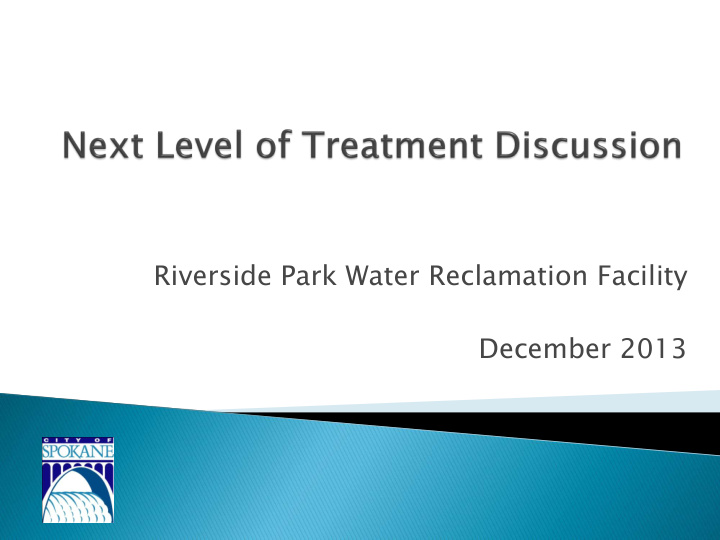



Riverside Park Water Reclamation Facility December 2013
How the City manages runoff • Separate Storm Sewers • Combined Storm & Sanitary Sewers • Evaporation • Infiltration • Impacts to the plant from CSO and incomplete separation
Initially, Integrated Plan was to include stormwater and CSO work. Changed thinking: ◦ Interconnectivity between stormwater, CSOs, interceptor capacity, and the plant capacity. ◦ Influence of stormwater on the size of the plant: Process avg 34 M Gallons of wastewater/day. But headworks sized to handle a flow rate of 125 million gallons/day. Recognized an opportunity to expand our right-sizing program to the plant.
City required to add additional treatment level at the wastewater plant: ◦ TMDL for dissolved oxygen/phosphorus ◦ Permit deadline for completion is March 2018 ◦ Completing a study to determine the best approach to achieve regulatory and financial goals. ◦ Working with Ecology now to receive approval for our approach. Report to Ecology due Jan. 7, 2014. ◦ Construction likely to begin in 2016.
Pretreatme tment nt: Removal of rocks, grit and larger debris. Primary: y: Settling of solids, floating of oils & grease. Solids and oils removed.* Seconda dary: ry: Separation and removal of smaller dissolved and suspended particles.* Tertiary ry (or Next Level of Treatment): Further level of filtration to remove even more pollution.* *(Digesters used to process all removed solids, oils, and suspended particles.)
Next Level of Treatment would add more pollution reduction for the River Phosphorus, PCBs, metals Optimize sizing of NLT Consider needs of NLT along with needs for CSO storage
Membrane technology sized at 50 million gallons a day capacity. Expand primary and secondary treatment to handle 125 million gallons a day. Include some “bypass” of tertiary (next level) of treatment in intense storms. Build facility so it’s expandable. Why? ◦ Net environmental benefit ◦ Lower life cycle costs ◦ Lower cost per pound of phosphorus removal Other option was sand filters sized at 100 MGD
Sand Filters Sand Filters 100 mgd 100 mgd HW HW PC PC SC SC NLT Disinf >100 mgd 4 4 MG MG If empty tank fills/overflows, then Treated CSOs Membranes Membranes 125 mgd 50 mgd HW HW PC PC SC SC NLT Disinf >50 mgd >125 mgd 2 2 MG MG If empty tank fills/overflows, then Treated CSOs
Infiltration & Inflow (I/I) reduction Efficient operation of NLT Water conservation Flexible operation of CSO regulators Connection between streets and stormwater ◦ Removal of stormwater from the combined system through the addition of green. ◦ Reduce stormwater to plant in incomplete separation areas.
Greater phosphorus and CBOD removal from membranes sized at 50 MGD than sand filter option. (CBOD is linked to dissolved oxygen) PCB removal is about the same. Membranes also effective at removing other pollutants, such as metals. And can get additional environmental benefits from running next level of treatment year round.
Total al Present t Worth of Filters and Membrane anes $150,000,000 r 2013 $) $125,000,000 ber nt Worth (Octobe $100,000,000 Conventional Filters 100 mgd $75,000,000 Membranes 50 mgd l Present $50,000,000 Total $25,000,000 $-
Cost of Phosphor orus us Removal oval During g Critical cal Season on $500 $450 $400 d) b TP Removed) $350 $300 $250 Cost ($/lb $200 $150 $100 $50 $- Conventional filters 50 mgd membranes
Sand Filter Outline
Integration is expanding! Thank you!
Recommend
More recommend